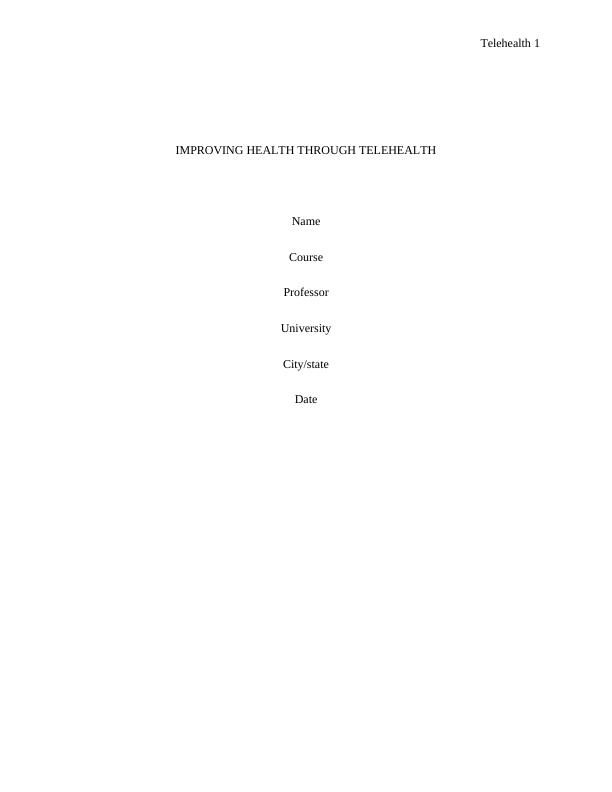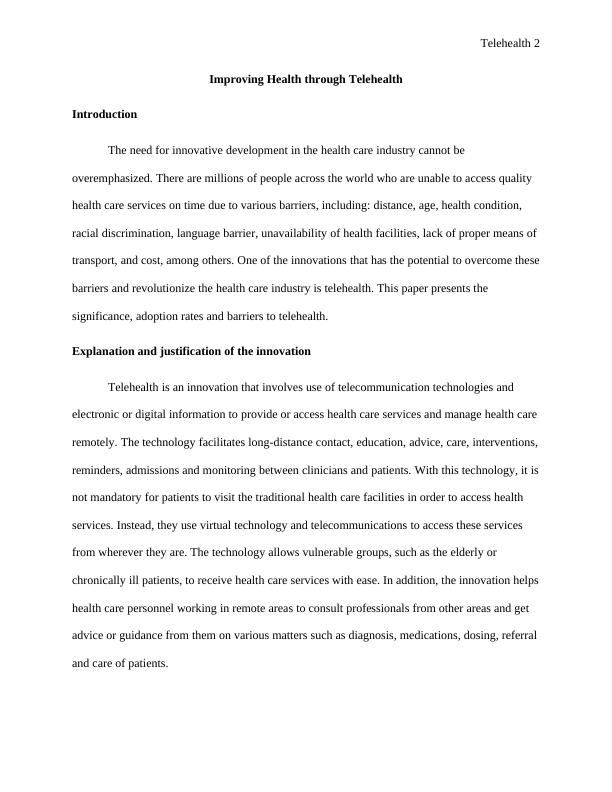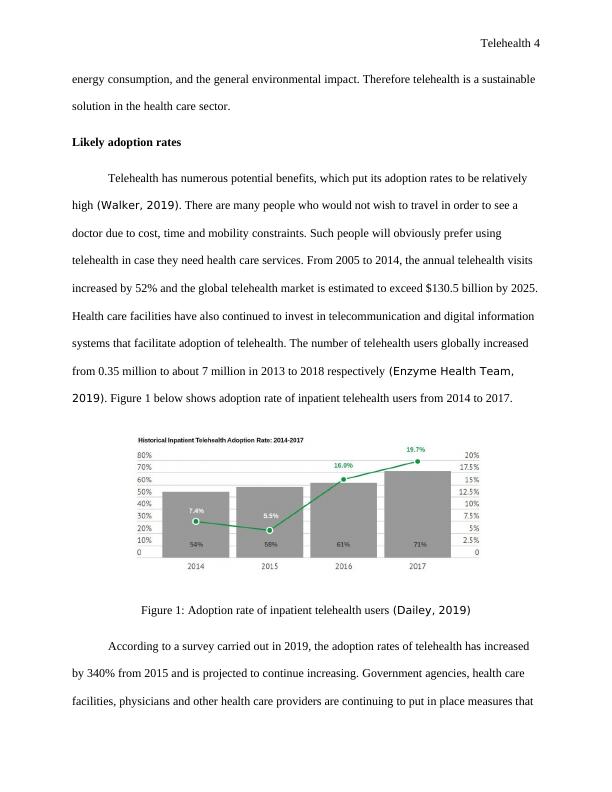Improving Health Through Telehealth
Added on 2022-08-27
11 Pages2358 Words16 Views
Telehealth 1
IMPROVING HEALTH THROUGH TELEHEALTH
Name
Course
Professor
University
City/state
Date
IMPROVING HEALTH THROUGH TELEHEALTH
Name
Course
Professor
University
City/state
Date

Telehealth 2
Improving Health through Telehealth
Introduction
The need for innovative development in the health care industry cannot be
overemphasized. There are millions of people across the world who are unable to access quality
health care services on time due to various barriers, including: distance, age, health condition,
racial discrimination, language barrier, unavailability of health facilities, lack of proper means of
transport, and cost, among others. One of the innovations that has the potential to overcome these
barriers and revolutionize the health care industry is telehealth. This paper presents the
significance, adoption rates and barriers to telehealth.
Explanation and justification of the innovation
Telehealth is an innovation that involves use of telecommunication technologies and
electronic or digital information to provide or access health care services and manage health care
remotely. The technology facilitates long-distance contact, education, advice, care, interventions,
reminders, admissions and monitoring between clinicians and patients. With this technology, it is
not mandatory for patients to visit the traditional health care facilities in order to access health
services. Instead, they use virtual technology and telecommunications to access these services
from wherever they are. The technology allows vulnerable groups, such as the elderly or
chronically ill patients, to receive health care services with ease. In addition, the innovation helps
health care personnel working in remote areas to consult professionals from other areas and get
advice or guidance from them on various matters such as diagnosis, medications, dosing, referral
and care of patients.
Improving Health through Telehealth
Introduction
The need for innovative development in the health care industry cannot be
overemphasized. There are millions of people across the world who are unable to access quality
health care services on time due to various barriers, including: distance, age, health condition,
racial discrimination, language barrier, unavailability of health facilities, lack of proper means of
transport, and cost, among others. One of the innovations that has the potential to overcome these
barriers and revolutionize the health care industry is telehealth. This paper presents the
significance, adoption rates and barriers to telehealth.
Explanation and justification of the innovation
Telehealth is an innovation that involves use of telecommunication technologies and
electronic or digital information to provide or access health care services and manage health care
remotely. The technology facilitates long-distance contact, education, advice, care, interventions,
reminders, admissions and monitoring between clinicians and patients. With this technology, it is
not mandatory for patients to visit the traditional health care facilities in order to access health
services. Instead, they use virtual technology and telecommunications to access these services
from wherever they are. The technology allows vulnerable groups, such as the elderly or
chronically ill patients, to receive health care services with ease. In addition, the innovation helps
health care personnel working in remote areas to consult professionals from other areas and get
advice or guidance from them on various matters such as diagnosis, medications, dosing, referral
and care of patients.

Telehealth 3
With this innovation, physicians can use wearable technology, big data and video
conferring technology to monitor patients remotely, discuss with them about symptoms and
make appropriate diagnosis. There are numerous telehealth tools and services that are designed
to meet the unique needs of different users. Some of these include: patient portal, virtual
appointments, remote monitoring, personal health app, wearable devices, personal health records
app and virtual consultations. The goals of telehealth are to improve accessibility of health care
services in isolated areas; make health care services more convenient and readily available for
persons with limited transportation, time or mobility options; make medical specialists easily
accessible; enhance self-management of health care; and enhance coordination and
communication of care among health care team members and patients. The innovation enables a
doctor to reach more patients who cannot afford or do not like to go to a physician. People with
chronic illness can benefit a lot from telehealth as they can continuously communicate with their
doctors from wherever they are. This enables the doctors to monitor their conditions timely by
use of data sent from their wearable devices and make informed decisions on appropriate
operations and medication.
Numerous benefits can be gained from use of this innovation. First, it can lead to
significant cost and time savings. Telehealth enables the patient to access quality health care
without spending time and money travelling to the doctor’s office. The innovation reduces
crowding of health care facilities because patients receive health care services remotely. It also
enhances creation of a resilient health care sector. Last but not least, telehealth minimizes
environmental impacts through the reduction of transport- and operational-related emissions,
which are enabled by the reduced number of patients’ visits to health care facilities. It also
results to fewer and smaller health facilities that reduces construction materials, waste, water and
With this innovation, physicians can use wearable technology, big data and video
conferring technology to monitor patients remotely, discuss with them about symptoms and
make appropriate diagnosis. There are numerous telehealth tools and services that are designed
to meet the unique needs of different users. Some of these include: patient portal, virtual
appointments, remote monitoring, personal health app, wearable devices, personal health records
app and virtual consultations. The goals of telehealth are to improve accessibility of health care
services in isolated areas; make health care services more convenient and readily available for
persons with limited transportation, time or mobility options; make medical specialists easily
accessible; enhance self-management of health care; and enhance coordination and
communication of care among health care team members and patients. The innovation enables a
doctor to reach more patients who cannot afford or do not like to go to a physician. People with
chronic illness can benefit a lot from telehealth as they can continuously communicate with their
doctors from wherever they are. This enables the doctors to monitor their conditions timely by
use of data sent from their wearable devices and make informed decisions on appropriate
operations and medication.
Numerous benefits can be gained from use of this innovation. First, it can lead to
significant cost and time savings. Telehealth enables the patient to access quality health care
without spending time and money travelling to the doctor’s office. The innovation reduces
crowding of health care facilities because patients receive health care services remotely. It also
enhances creation of a resilient health care sector. Last but not least, telehealth minimizes
environmental impacts through the reduction of transport- and operational-related emissions,
which are enabled by the reduced number of patients’ visits to health care facilities. It also
results to fewer and smaller health facilities that reduces construction materials, waste, water and

Telehealth 4
energy consumption, and the general environmental impact. Therefore telehealth is a sustainable
solution in the health care sector.
Likely adoption rates
Telehealth has numerous potential benefits, which put its adoption rates to be relatively
high (Walker, 2019). There are many people who would not wish to travel in order to see a
doctor due to cost, time and mobility constraints. Such people will obviously prefer using
telehealth in case they need health care services. From 2005 to 2014, the annual telehealth visits
increased by 52% and the global telehealth market is estimated to exceed $130.5 billion by 2025.
Health care facilities have also continued to invest in telecommunication and digital information
systems that facilitate adoption of telehealth. The number of telehealth users globally increased
from 0.35 million to about 7 million in 2013 to 2018 respectively (Enzyme Health Team,
2019). Figure 1 below shows adoption rate of inpatient telehealth users from 2014 to 2017.
Figure 1: Adoption rate of inpatient telehealth users (Dailey, 2019)
According to a survey carried out in 2019, the adoption rates of telehealth has increased
by 340% from 2015 and is projected to continue increasing. Government agencies, health care
facilities, physicians and other health care providers are continuing to put in place measures that
energy consumption, and the general environmental impact. Therefore telehealth is a sustainable
solution in the health care sector.
Likely adoption rates
Telehealth has numerous potential benefits, which put its adoption rates to be relatively
high (Walker, 2019). There are many people who would not wish to travel in order to see a
doctor due to cost, time and mobility constraints. Such people will obviously prefer using
telehealth in case they need health care services. From 2005 to 2014, the annual telehealth visits
increased by 52% and the global telehealth market is estimated to exceed $130.5 billion by 2025.
Health care facilities have also continued to invest in telecommunication and digital information
systems that facilitate adoption of telehealth. The number of telehealth users globally increased
from 0.35 million to about 7 million in 2013 to 2018 respectively (Enzyme Health Team,
2019). Figure 1 below shows adoption rate of inpatient telehealth users from 2014 to 2017.
Figure 1: Adoption rate of inpatient telehealth users (Dailey, 2019)
According to a survey carried out in 2019, the adoption rates of telehealth has increased
by 340% from 2015 and is projected to continue increasing. Government agencies, health care
facilities, physicians and other health care providers are continuing to put in place measures that

End of preview
Want to access all the pages? Upload your documents or become a member.
Related Documents
Telehealth Project: System Analysis and Designlg...
|8
|1280
|71
Telehealth Project: Vision Document for Improving Healthcare in Rural Areaslg...
|8
|1545
|229
Nursing Informatics Telehealth - Doclg...
|6
|919
|131
Telehealth Programs | Essaylg...
|14
|3896
|21
Effective use of patient-care technologies in Telehealthlg...
|7
|1597
|252
Telehealth Technology in Managing Chronic Diabeteslg...
|12
|3231
|28
